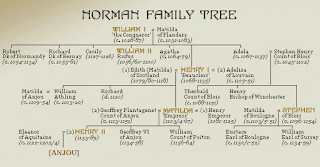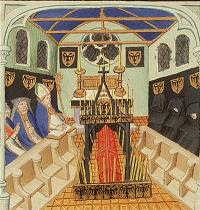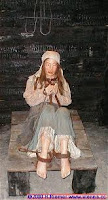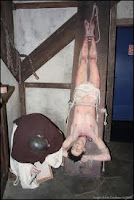(5) In 1127 it is said in the Anglo-Saxon chronicles that King Henry I, held his court at Christmas, in Windsor. There was David King of the Scots and all the head men that were in England, learned and lewd. There, he engaged the archbishops, bishops, abbots, earls and all the thegns (Norman Knights and free men) that were there to swear England and Normandy, after his death, into the hands of his daughter Matilda (Athelicia).
Afterwards, Matilda, who was formerly the wife of the Emperor of Saxony, was sent by Henry, to Normandy. With her went her brother Robert, Earl of Gloucester and Brian, son of the Earl, Alan Fergan. Henry had arranged for her to wed the son of the Earl of Anjou, named Geoffrey Martel. All the French and English however, disapproved of this, but the King needed to forge an alliance with the Earl of Anjou, in order to have help against his nephew, William Clito, who was the son of his brother Robert, the former Earl of Normandy.
After the tragedy of the White Ship in 1120, which took the life of Henry's son, the obvious male heir to England and Normandy was now, William Clito. Henry had been successful in writing his brother out of the succession, so he was not about to hand over, 'keys to the kingdom', to his brother's son. Henry needed to secure the throne and his only option was his daughter. But a woman on the throne of England. . .? Nevertheless, the barons swore an oath to recognise Henry's daughter, Matilda, as heir to her fathers kingdom.
Within a year, William Clito was involved in the siege of Aalst, in the province of East Flanders. During a fracas with a foot soldier, he sustained an injury to his arm. The wound became severely infected and he subsequently died from gangrene. Thereafter, the succession to the throne of England to favour Matilda, seemed in little doubt.
By 1135, the year Henry died, there is no mention of Matilda in the Anglo-Saxon chronicles. That may hardly be surprising, as she was not a very liked woman. She is described as being very bad-tempered and having a disagreeable nature. The chronicles do talk about the anarchy that followed the death of King Henry between his nephew Stephen, Count of Blois and Matilda's supporters. The throne had been seized by Stephen, under the willingness of the barons, while Matilda was in Normandy, pregnant with her third child. The first mention of Matilda is in 1140, but it is worth pointing out that the dates in the chronicles are not always correct. Some years have been missed out while others have been duplicated. It says that in 1135:-
'...the day darkened over all lands, and the sun was all as it were a three night old moon,...'We know there was a solar eclipse in 1132, so Henry may have died in 1132.
When Henry named his daughter as heir, he knew that under Norman Law all property and rights belonged to men. For medieval times, being ruled by a woman was inconceivable to most men. A woman could not defend herself on a battlefield, therefore, could not have the makings to be a strong King. Knowing this, Henry still hoped he had won the loyalty of his nobles to recognise his daughter as his chosen heir. He of course had not. This decision by Henry proved to be catastrophic for the people of England. Furthermore, what made Matilda's position even more precarious was her marriage to the Frenchman, Count Geoffrey of Anjou.
 |
| NORMAN TREE SHOWING STEPHEN'S LINE |
KING STEPHEN 1135
 |
| CROWING OF KING STEPHEN |
On the 26th of December, 1135, the Archbishop of Canterbury, William Curboil, was persuaded to crown Stephen, at Westminster Abbey. The oath that had been taken to support Matilda's claim, was argued to be invalid as it had been taken by force. Rumours also circulated around court that Henry had changed his mind about the succession on his deathbed, to favour Stephen. This was untrue of course.
Soon after Stephen had been crowned, some of the barons started to have serious doubts on his ability to be a strong king. He was found to be soft and made bad decisions. Although his supporters describe him as a likeable, friendly man, who always tried, through adversity, to remain upbeat.
 |
| STEPHEN'S COAT OF ARMS |
At a later date, Stephen would seize the Chancellor, Bishop Roger of Salisbury and his two nephews Alexander, Bishop of Lincoln and Nigel, bishop of Ely. This would prove to be a serious mistake on behalf of Stephen.
The king threw many barons into the tower until they gave up their castles, but once the 'traitors' realised that Stephen was soft and that no punishment was being imposed, they got to thinking..... They decided to pay homage to Stephen in order to secure their release. Once released, they returned to their castles and set about the task of reinforcing them. Soon the land filled with fortified castles, ready to be held against the King.
Walkelin Maminot was stationed at Dover castle, which was soon taken possession of by the Queen's forces (Stephen's wife). Walkelin also held Oakham castle; Robert, the son of Alured of Lincoln, held the castles of Wareham and Morguan; Ralf Paganel held Ludlow; and Eustace Fitz-John held Alnwick, Bamburgh and Malton; William of Mohun held Dunster castle in Somersetshire; William Louvel held Cary castle in Somersetshire; and William Fitz-John held Harptree, also in Somersetshire; William Fitz-Alan had garrisoned the castle of Shrewsbury; while William Peverel was in possession of the towns of Brunam, Ellesmere, Overton and Wintenton.
 |
| BRISTOL CASTLE |
The castle at Bristol had been strongly fortified by Earl Robert and stored with plenty of provisions. It later became the main headquarters for Matilda's supporters. From Bristol, the barons would make frequent inroads to the inhabitants in the towns and with barbarous violence and torture, took all their money and properties. A kinsman of Earl Robert, named Phillip de Gai, invented engines of torture and in a short time, all the castles of these barons held his engines.
The barons forced labour on the people and when the castles were built they filled them with;-
'devils and evil men'
Poor wretched men were thrown into prison for their gold and silver and inflicted with unimaginable pains and suffering. The chronicles say;-
'for never were any martyrs so tortured as they were.'
Men were suspended by their feet for hours on end, while malodorous smoke washed over them. Others hanged by the thumbs or by their head, with coats of mail draped across their feet. Knotted string would be tied around the head and twisted until the pain went to their brains. Some people were placed in, what was called, a 'crucet-house', which was a short, narrow chest containing razor sharp stones. The unfortunate soul would be placed inside the chest, thereupon forcing the stones straight through the body, breaking all his limbs. A truly horrific ordeal!
Many forms of torture was being used in these castles, another one most feared was called the 'Sachenteges'. The sachenteges was an instrument of torture that no man could bear. The device consisted of a sharp, spiked, iron collar, which was suspended from a beam so the wearer could not sit or lie down to sleep, but at all times bear the weight of the iron around his neck.
'This is what it must be like to live in hell', it must have been said.Many forms of torture was being used in these castles, another one most feared was called the 'Sachenteges'. The sachenteges was an instrument of torture that no man could bear. The device consisted of a sharp, spiked, iron collar, which was suspended from a beam so the wearer could not sit or lie down to sleep, but at all times bear the weight of the iron around his neck.
For these poor, tortured souls their ordeal didn't end there;- finally thrown into dungeons, they were left for the Adders, snakes and toads to devour. - 'The Dark Ages' - and so it was, it was dark, dark times indeed.
Many thousands died across the land from hunger. Their towns burnt-out once they had no more goods to give. Anarchy shortly followed. This went on for 19 years, during the whole of Stephen's reign and it got worse and worse.
Some folk had 'recourse to alms', charity, which for a while made them rich men and some folks fled the country. Neither church nor churchyard was spared, once the church was emptied, it was burnt to the ground. Every man robbed another. If two or three men came to town, all the people ran for them, deciding that they must be robbers. A fear of strangers had gripped the land. The bishops and learned men cursed them, but with little effect. To the people, they had been abandoned. The fields grow no corn, the land was all a waste. It was said openly that 'Christ and his saints slept'.
Matilda had spent two years trying to raise an army to fight her cousin Stephen. Once Earl Robert joined her cause, she had a base from which to operate from, in England. Earl Robert was an influential man and had plenty of supporters. The barons now had a strong, male leader to follow and very quickly joined his campaign against Stephen.
In March 1138 Geoffrey Talbot, who was a cousin of Ilbet de Lacy, seized the castle at Hereford and held the town for Matilda. Stephen marched against Talbot and surrounded the castle intensely, for many weeks. By May of that year the castle had surrendered. Geoffrey Talbot managed to escape capture and fled to Weobley Castle in Herefordshire, which belonged to the de Lacy family. Stephen ordered for Hereford castle to be destroyed. Weobley castle, like Hereford, soon fell to Stephen also and before long both castles were strongly garrisoned with royal forces. Talbot, yet again, escaped the clutches of Stephen and fled to Bristol, the main headquarters of Matilda's supporters.
Before long, Talbot and de Lacy launched an attack on the town of Bath, but while out scouting, they were attacked by the forces from the city. Talbot was immediately captured by soldiers under the control of the bishop of Bath, Robert of Lewes and thrown into dungeons. After which, Matilda's forces promptly arranged a meeting with the bishop and offered him a safe conduct, but when the bishop arrived, he was threatened with hanging unless Talbot was released. The bishop, having no option, released Talbot, but Stephen later accused the bishop of supporting Matilda and was only with difficulty, persuaded to accept the bishop's explanation. Wherefore, Stephen hastily gathered his forces and headed for Bristol, but the castle had been strongly fortified by Earl Robert. Stephen soon abandoned the siege, but not before plundering and devastating the surrounding country. He decided to direct his course towards Cary castle and Harptree instead, which were held by Ralf Louvel and William Fitz-John. Both these barons were united to Earl Robert by ties of friendship and by the oath of vassalage, which was an oath of homage to a lord of another domain. In return for this pledge the barons would receive land and protection from the lord, in this case Earl Robert, Matilda's half brother.
In the belief that the King was engaged in a tedious siege at Bristol, Ralf Louvel and William Fitz-John laid waste and plundered all the neighbouring country in Somersetshire, but Stephen soon appeared in front of Cary castle, to which he laid siege. He showered the castle day and night with fire and stones until the castle finally compelled to surrender.
From Cary castle Stephen proceeded to Harptree, where he erected a fort which was manned from the garrison at Bath. Some time after, when Stephen was passing by Harptree castle, the garrison came out and attacked the rear of Stephen's army. Stephen made a rapid retrograde movement with his cavalry, but found the place nearly deserted. The King commanded fire to be applied to the gates and scaling ladders and other engines to the walls. He soon reduced the remainder of the garrison to deliver up the castle. Stephen now proceeded to Dudley castle, but Ralf Paganel had strongly fortified it. After failing to take the castle, Stephen laid waste to the surrounding area and people, before marching on to Shrewsbury.
Shrewsbury castle was being held by William Fitz-Alan. On hearing of Stephen’s approach, he secretly fled with his wife and children, leaving behind those who had bound themselves by oath not to surrender. Having failed to capture the castle for many days, Stephen ordered for huge amounts of wood to be piled in the ditch and set on fire. The men on the wall either fell or fled from the billowing smoke that now filled the castle, but were hastily pursued and put to the sword. William Fitz-Alan’s uncle, Amulf of Hesdin and four other noble men were hanged by the king’s order.
Over at Dover castle, which was being held by Walkelin Maminot, the Queen’s forces had besieged it in vain, while her troops from Boulogne endeavoured to cut off all supplies by sea. On hearing what had taken place at Shrewsbury, Walkelin made the decision to surrender this part of England.
While King Stephen was engaged in rebellions in the south and the invasion of the north from King David, the Danish king, Eric Lamb, landed. He had been inspired with the belief that he had legal rights to the crown of England as it had been worn by Cnut and his sons. He believed he had more right than those 'Frenchified Normans.' He himself, must have regarded this as weak, when he deemed it necessary to support his claim by the extraordinary and unheard of argument that the common washing, of his own and the English coast by the German ocean, gave him the preferable right. Stephen did not instantly attack the Danes who had landed, but allowed them to disperse in search of booty. Then, Stephen attacked their isolated camps and succeeded in breaking their power and driving them back.
Many thousands died across the land from hunger. Their towns burnt-out once they had no more goods to give. Anarchy shortly followed. This went on for 19 years, during the whole of Stephen's reign and it got worse and worse.
Some folk had 'recourse to alms', charity, which for a while made them rich men and some folks fled the country. Neither church nor churchyard was spared, once the church was emptied, it was burnt to the ground. Every man robbed another. If two or three men came to town, all the people ran for them, deciding that they must be robbers. A fear of strangers had gripped the land. The bishops and learned men cursed them, but with little effect. To the people, they had been abandoned. The fields grow no corn, the land was all a waste. It was said openly that 'Christ and his saints slept'.
REBELLIONS IN THE SOUTH
Matilda had spent two years trying to raise an army to fight her cousin Stephen. Once Earl Robert joined her cause, she had a base from which to operate from, in England. Earl Robert was an influential man and had plenty of supporters. The barons now had a strong, male leader to follow and very quickly joined his campaign against Stephen.
In March 1138 Geoffrey Talbot, who was a cousin of Ilbet de Lacy, seized the castle at Hereford and held the town for Matilda. Stephen marched against Talbot and surrounded the castle intensely, for many weeks. By May of that year the castle had surrendered. Geoffrey Talbot managed to escape capture and fled to Weobley Castle in Herefordshire, which belonged to the de Lacy family. Stephen ordered for Hereford castle to be destroyed. Weobley castle, like Hereford, soon fell to Stephen also and before long both castles were strongly garrisoned with royal forces. Talbot, yet again, escaped the clutches of Stephen and fled to Bristol, the main headquarters of Matilda's supporters.
 |
| Site of Weobley Castle Only earthworks now remain of Weobley Castle, they suggest that at its prime it was a substantial castle. |
In the belief that the King was engaged in a tedious siege at Bristol, Ralf Louvel and William Fitz-John laid waste and plundered all the neighbouring country in Somersetshire, but Stephen soon appeared in front of Cary castle, to which he laid siege. He showered the castle day and night with fire and stones until the castle finally compelled to surrender.
From Cary castle Stephen proceeded to Harptree, where he erected a fort which was manned from the garrison at Bath. Some time after, when Stephen was passing by Harptree castle, the garrison came out and attacked the rear of Stephen's army. Stephen made a rapid retrograde movement with his cavalry, but found the place nearly deserted. The King commanded fire to be applied to the gates and scaling ladders and other engines to the walls. He soon reduced the remainder of the garrison to deliver up the castle. Stephen now proceeded to Dudley castle, but Ralf Paganel had strongly fortified it. After failing to take the castle, Stephen laid waste to the surrounding area and people, before marching on to Shrewsbury.
Shrewsbury castle was being held by William Fitz-Alan. On hearing of Stephen’s approach, he secretly fled with his wife and children, leaving behind those who had bound themselves by oath not to surrender. Having failed to capture the castle for many days, Stephen ordered for huge amounts of wood to be piled in the ditch and set on fire. The men on the wall either fell or fled from the billowing smoke that now filled the castle, but were hastily pursued and put to the sword. William Fitz-Alan’s uncle, Amulf of Hesdin and four other noble men were hanged by the king’s order.
Over at Dover castle, which was being held by Walkelin Maminot, the Queen’s forces had besieged it in vain, while her troops from Boulogne endeavoured to cut off all supplies by sea. On hearing what had taken place at Shrewsbury, Walkelin made the decision to surrender this part of England.
While King Stephen was engaged in rebellions in the south and the invasion of the north from King David, the Danish king, Eric Lamb, landed. He had been inspired with the belief that he had legal rights to the crown of England as it had been worn by Cnut and his sons. He believed he had more right than those 'Frenchified Normans.' He himself, must have regarded this as weak, when he deemed it necessary to support his claim by the extraordinary and unheard of argument that the common washing, of his own and the English coast by the German ocean, gave him the preferable right. Stephen did not instantly attack the Danes who had landed, but allowed them to disperse in search of booty. Then, Stephen attacked their isolated camps and succeeded in breaking their power and driving them back.




No comments:
Post a Comment